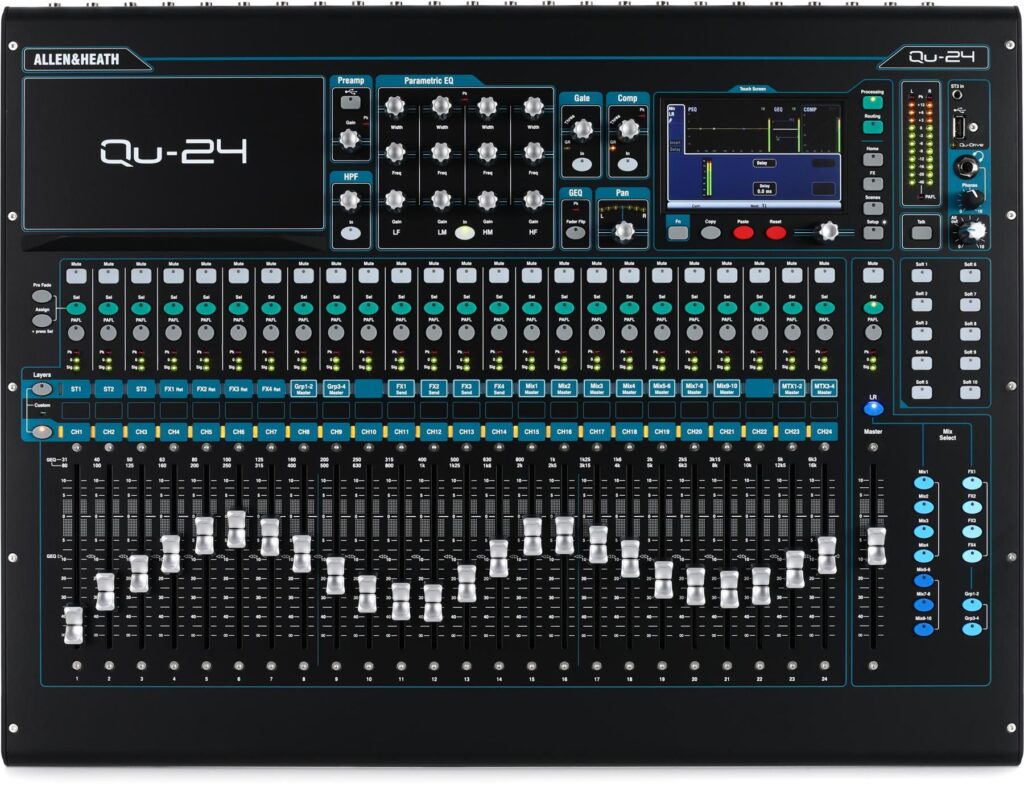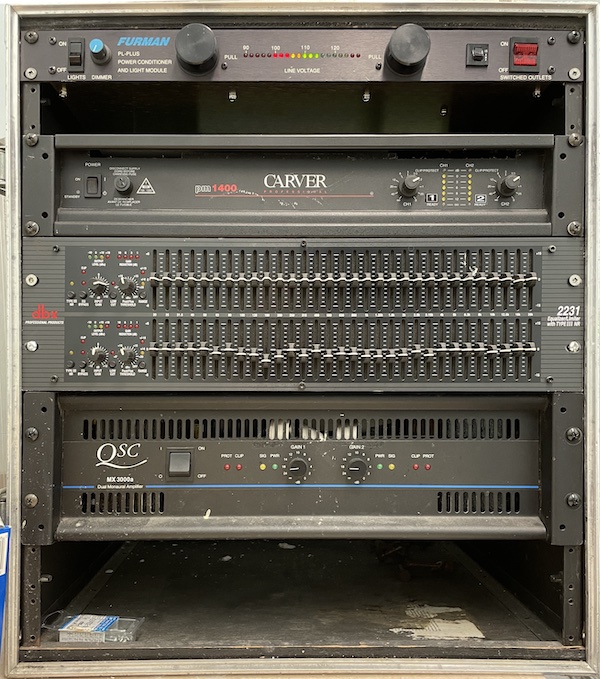We have a fairly standard audio system in our church.
Mixer
We have an Allen and Heath QU-24 digital mixer:
The mixer has several outputs: LR for Front of House, Mix 1, Mix 2, and Mix 3 for band monitors, Mix 5 for the Subwoofer, Mix 7 for the Auxiliary speakers, and Mix 9-10 for Zoom. (Note: Mix 5-6, 7-8, and 9-10 are stereo mixes but we only use the left sides for the subwoofer and auxiliary speakers as these destinations are mono. The QU-24 allows us to select pre or post-fader for individual inputs allowing for a lot of flexibility in our various mixes.)
- Youtube video: introducing QU series
- Youtube video: training video for QU series
- Pro Audio EXP training course for QU Series (login as rezTechTeam@gmail.com)
- Getting Started Guide
- Reference Gude
There is a power switch underneath the sound desk on top of the drawers that powers the mixer and wireless receivers.
Note: the mixer is password protected.
Amplifier Stack
Our amplifiers are mounted in a rack in the Wardens Office. A Furman power conditioner provides power to the whole rack.
Audio coming from the mixer (LR) goes to the dbx 2231 Equalizer and from there goes to the QSC amplifier. (Note: the new mixer can also perform equalization so in theory we could remove this equalizer and do everything with the mixer.)
The QSC MX3000a amplifier is connected to the main speakers. Note: the input is non-standard on the amplifier: input pins 2 and 3 (Tip and Ring) are switched (180º out of phase). To get back in phase with the rest of the system we switch the speaker connectors on the amplifier’s output (black->red, red->black).
The Carver pm1400 amplifier (schematics) is connected to the auxiliary speakers further back in the sanctuary. For now we are only sending the vocal mikes to these speakers to reduce the possibility of blown speakers.
Speakers
We have three pairs of speakers. The main, front of house, speakers are EV ZX3.
The second two pairs are auxiliary speakers (EV EVID 6.2) and are placed on pillars further back in the sanctuary. The signal to these speakers is delayed at the mixer so that sound from these speakers and the main speakers arrive at the same time at the back of the sanctuary
There is an EV ZXA1-Sub subwoofer to the left front of the church.
Monitors
We have up to four EV ZxA1 powered monitors at the front for the musicians.
Microphones
We have five Sennheiser e865 super-cardioid condenser microphones for vocals. We also have several Audio-Technica MB4k cardioid condenser microphones.
We have a Shure MX418/C at the lectern and a Shure MX418/S at the pulpit.
For the drums we have a pair of Rode M5 mics on top and a Shure PGA52 mic on the bass drum.
We have Sennheiser EM 100 G3 wireless microphone system with a lavalier microphone for Julie. The microphone and the body pack transmitter are in the top drawer at the mixing desk. (Lately we have had noise coming from the receiver if the transmitter hasn’t been turned on so you need to power-up the receiver separately.)
We have two EV RE-2 wireless microphone systems with both a handheld mike and two lavalier microphones. They are in the middle drawer.
Snake
We have a 16 input/4 return snake from the right front of the church to the mixer. (I suspect that return signal A is working intermittently but haven’t investigated further.)
What to Do Sunday Morning
- First turn on the power switch under the sound desk to power up mixer (important that this is first)
- turn on the musicians’ monitors and subwoofer.
- go the Wardens Office and turn on the Furman power conditioner to power up the amplifiers.
- Give Julie her wireless microphone.
When it’s time to power-down the system make sure to do that in reverse order as above (this is the important part: turn off the mixer last). Before you turn off the power switch please put the mixer in shut-down mode (Go to Home on the mixer and select Shut Down). Remove the batteries from the wireless mikes.
Bibliography
- Professional Mixing Tips for Church Sound, Shure
- The Church Sound Survival Guide, Kilpatrick
- Sound at the Rez, Lee Fletcher, 2013
- Musical Instrument Frequency Ranges
- DI Boxes, Musician’s Friend
- Audio terms and definitions, AES
- An earlier version of this document



